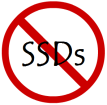Flash storage is at an interesting place and it’s worth taking the
time to understand IBM’s new FlashSystem 840 and how it might be useful.
A traditional approach to flash is to treat it like a fast disk drive
with a SAS interface, and assume that a faster version of traditional
systems are the way of the future. This is not a bad idea, and with
auto-tiering technologies this kind of approach was mastered by the big
vendors some time ago, and can be seen for example in IBM’s Storwize
family and DS8000, and as a cache layer in the XIV. Using auto-tiering
we can perhaps expect large quantities of storage to deliver latencies
around 5 millseconds, rather than a more traditional 10 ms or higher
(e.g. MS Exchange’s jetstress test only fails when you get to 20 ms).

Some players want to use all SSDs in their disk systems, which you
can do with Storwize for example, but this is again really just a
variation on a fairly traditional approach and you’re generally looking
at storage latencies down around one or two millseconds. That sounds
pretty good compared to 10 ms, but there are ways to do better and I
suspect that SSD-based systems will not be where it’s at in 5 years
time.
The IBM FlashSystem 840 is a little different and it uses flash
chips, not SSDs. It’s primary purpose is to be very very low latency.
We’re talking as low as 90 microseconds write, and 135 microseconds
read. This is not a traditional system with a soup-to-nuts software
stack. FlashSystem has a new Storwize GUI, but it is stripped back to
keep it simple and to avoid anything that would impact latency.
This extreme low latency is a unique IBM proposition, since it turns
out that even when other vendors use MLC flash chips instead of SSDs, by
their own admission they generally still end up with latency close to 1
ms, presumably because of their controller and code-path overheads.

- 2u appliance with hot swap modules, power and cooling, controllers etc
- Concurrent firmware upgrade and call-home support
- Encryption is standard
- Choice of 16G FC, 8G FC, 40G IB and 10G FCoE interfaces
- Choice of upgradeable capacity
| Nett of 2-D RAID5 | 4 modules | 8 modules | 12 modules |
| 2GB modules | 4 TB | 12 TB | 20 TB |
| 4GB modules | 8 TB | 24 TB | 40 TB |
- Also a 2 TB starter option with RAID0
- Each module has 10 flash chips and each chip has 16 planes
- RAID5 is applied both across modules and within modules
- Variable stripe RAID within modules is self-healing
I’m thinking that prime targets for these systems include Databases
and VDI, but also folks looking to future-proof their general
performance. If you’re making a 5 year purchase, not everyone will want
to buy a ‘mature’ SSD legacy-style flash solution, when they could
instead buy into a disk-free architecture of the future.
But, as mentioned, FlashSystem does not have a full traditional
software stack, so let’s consider the options if you need some of that
stuff:
- IMHO, when it comes to replication, databases are usually best replicated using log shipping, Oracle Data Guard etc.
- VMware volumes can be replicated with native VMware server-based tools.
- AIX volumes can be replicated using AIX Geographic Mirroring.
- On AIX and some other systems you can use logical volume mirroring to set up a mirror of your volumes with preferred read set to the FlashSystem 840, and writes mirrored to a V7000 or (DS8000 or XIV etc), thereby allowing full software stack functions on the volumes (on the V7000) without slowing down the reads off the FlashSystem.
- You can also virtualize FlashSystem behind SVC or V7000
- Consider using Tivoli Storage Manager dedup disk to disk to create a DR environment
Right now, FlashSystem 840 is mainly about screamingly low latency
and high performance, with some reasonable data center class
credentials, and all at a pretty good price. If you have a data
warehouse, or a database that wants that kind of I/O performance, or a
VDI implementation that you want to de-risk, or a general workload that
you want to future-proof, then maybe you should talk to IBM about
FlashSystem 840.
By: Jim
Aucun commentaire:
Enregistrer un commentaire